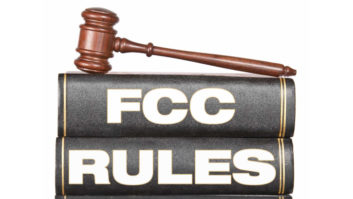Fourteen low-power digital TV stations in nine states can continue to provide analog radio services at the bottom of the FM dial, under a plan approved unanimously by the Federal Communications Commission today.
They essentially are grandfathered in after a two-year trial period, thus resolving a longstanding regulatory question about whether the radio-like operations of “FM6” or “Franken” stations were appropriate given their TV licenses.
But in taking this action, the commission declined to make more substantial changes in the use of the 82–88 MHz spectrum.
National Association of Broadcasters President/CEO Curtis LeGeyt called the outcome a “fair and efficient resolution” and said it would “protect Channel 6 television operators while recognizing the audience built by existing FM6 stations.”
We previewed this vote earlier this month.
No more baling wire
The commission said the radio programming of these stations had “a long history of public interest benefits.”
The practice apparently began in the 1980s, and at one time about 30 such stations were operating, aiming to reach listeners whose radios could pick up Channel 6 audio spectrum just below the licensed FM dial.
Some broadcasters felt it was a dubious or illegal practice; but looking back on it in issuing her statement today, Chairwoman Jessica Rosenworcel sounded approving: “Ultimately this led to more broadcast services to more people in the community.”
But after the 2021 LPTV digital transition, newly digital stations that had been providing FM6 service were no longer able to reach analog radio audiences through these TV transmissions.
However, 13 stations remained on the air under special temporary authority, subject to a set of rules laid out by the FCC for this situation. Among other things they had to convert to ATSC 3.0 digital; provide at least one video stream on the ATSC 3.0 portion; operate on a non-interference basis; and provide audio and video coverage to similar populations.
Rosenworcel said that this kept the stations on the air “with the equivalent of regulatory gum and baling wire. Now it is time for something sturdier and more permanent.”
She said, “We have had two years of experience with this arrangement and no incidents of interference with television operations and adjacent licensees, including other stations on FM radio. … [W]e know in a world where content feels like it is everywhere, there is still something special about local radio and a signal in the air.”
Those 13 are grandfathered in as ancillary or supplementary services. They are KBKF, San Jose, Calif. (whose STA request appears to have set the precedent for this group); WMTO, Norfolk, Va.; KXDP, Denver, Colo.; WTBS, Atlanta, Ga.; WRME, Chicago, Ill.; KZNO, Big Bear Lake, Calif.; KEFM, Sacramento, Calif.; WEYS, Miami, Fla.; WDCN, Fairfax, Va.; KRPE, San Diego, Calif.; KGHD, Las Vegas, Nev.; WPGF, Memphis, Tenn.; and WNYZ, New York, N.Y. Most if not all of them operate on a commercial basis.
The FCC also will allow WVOA in Westvale, N.Y., which it allowed under special circumstances; the station will have to operate under an STA until the commission determines that interference won’t be an issue.
But the order declines to allow other past FM6 operators to come back on or allow new ones. WJMF in Jackson, Miss., and KBFW in Arlington, Texas, are two that wanted to resume service but won’t be allowed.
Public service cited
The commission wrote that the 14 approved broadcasters have maintained a close connection with the communities they serve through their programming. “Listeners have tuned to existing FM6 LPTV stations for foreign language, religious and sports programming; programming intended to support historically underserved populations such as native Spanish speakers, immigrant populations; and programming designed for niche music audiences. In addition, existing FM6 LPTV stations provide emergency and public safety information that their listeners have come to rely upon in times of disasters.”
Rosenworcel name-checked WDCN in northern Virginia near Washington, D.C., citing its programming to people tied to Central America including El Salvador, Honduras and Guatemala.
Most of the STA requirements will remain in place as permanent rules for the 14 stations. The commission believes this will ensure that the stations “are first and foremost LPTV stations and that their video programming stream is prioritized over any audio stream,” rather than operating with minimal video services.
The stations must operate on 87.75 MHz; the FCC declined to allow any at 87.7. They must be able to air EAS alerts separately on both their television and their FM6 operations. And although LPTV stations are not required to maintain online public inspection files, they’ll have to keep one for FM6 operations.
Under the order, these FM6 stations can be assigned or transferred. Modifications to their technical facilities are allowable only within their current protected contour or in special circumstances like loss of a tower site.
The FM6 stations had picked up the moniker “Frankens” after Radio World began using a term that had appeared on an engineering listserv. The name referenced what some saw as an unholy pairing of two types of broadcast licenses, akin to the cobbled-together nature of Frankenstein’s monster.
The commission did not accept a proposal from NPR to repurpose the 82–88 MHz spectrum for FM services in locations where channels are not being used for TV programming.
And it did not act on an NPR proposal to allow existing NCE FM stations to relocate to 87.9 MHz. “As this change could impact our revisions to the TV6 interference rules, we find that it would be more appropriate to consider NPR’s proposal in conjunction with a future TV6 interference proceeding.”






